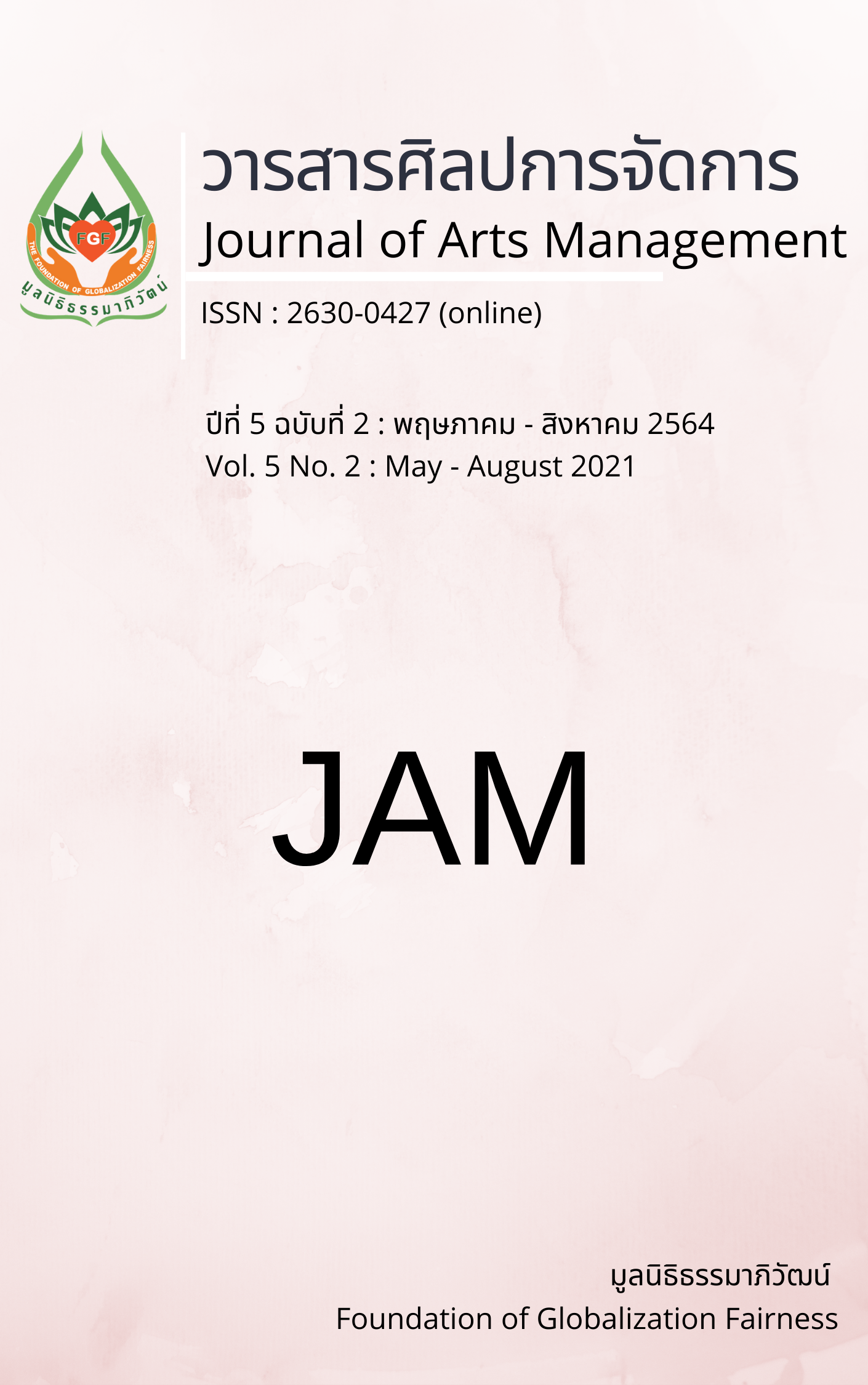Causal Factors Affecting Purchase Intention Fashion Product on Instagram of Consumers in Thailand
Main Article Content
Abstract
This study aimed to 1) develop and validate the consistency a causal relationship model of purchase intention fashion product on Instagram; 2) study the causal factors affecting purchase intention fashion product on Instagram of consumers in Thailand. This research methodology was a quantitative research. A sample was people who have bought a fashion product on Instagram and lived in Thailand of 360 people was obtained by quota sampling. The tools used in the research were online questionnaires. The statistics used in data analysis were frequency, percentage and structural equation model. The research results were found as follows:
1. The causal relationship model consisted of 6 components were 1) Instagram Informativeness 2) Credibility 3) Value 4) Entertainment 5) Attitude and 6) Purchase Intention and the model consistent with the empirical data to a great extent. The statistic showed the Chi-square statistics goodness fit test (2) = 464.78, degrees of freedom (df) = 342, CMIN/df = 1.35, GFI = 0.92, AGFI = 0.90, SRMR = 0.03, RMSEA = 0.03. The final was predictive coefficient of 0.95, indicating that the variables in the model can explain the variance of the purchase intention fashion product on Instagram by 95 percent.
2. The causal factors affecting purchase intention fashion product on Instagram were the most value and the most, secondly by 1) Entertainment 2) Credibility 3) Informativeness 4) Attitude respectively. Entrepreneurs who sell fashion products on Instagram able to use knowledge to create purchase intention that will result in business success and stability.
Article Details
Views and opinions appearing in articles in the Journal of Arts of Management It is the responsibility of the author of the article. and does not constitute the view and responsibility of the editorial team I agree that the article is copyright of the Arts and Management Journal.
References
กริช แรงสูงเนิน. (2554). การวิเคราะห์ปัจจัยด้วย SPSS และ AMOS เพื่อการวิจัย. กรุงเทพฯ: บริษัท วี.พริ้นท์ (1991) จำกัด.
คเณศ ไชยพร. (2556). การศึกษาการแบงกลุ่มพฤติกรรมการซื้อเสื้อผ้าผานเครือข่ายสังคมออนไลน์เฟซบุ๊คในเขตกรุงเทพมหานคร. สืบค้นเมื่อ 1 มีนาคม 2564, จาก https://searchlib.utcc.ac.th/library/onlinethesis/263418.pdf
ชลชินี บุนนาค และ ปภาภรณ์ ไชยหาญชาญชัย. (2561). การสำรวจภาพแบบการดำเนินชีวิตบนอินสตาแกรม. การประชุมวิชาการเสนอผลงานวิจัยระดับชาติ ครั้งที่ 1, มหาวิทยาลัยราชภัฏสวนสุนันทา, 29 มิถุนายน 2561, 206 – 207.
ชลธิชา ศรีบำรุง. (2557). คุณภาพการให้บริการของธนาคารกรุงเทพ สาขาดอนหัวฬ่อ จังหวัดชลบุรี(วิทยานิพนธ์รัฐประศาสนศาสตรมหาบัณฑิต). วิทยาลัยการบริหารรัฐกิจ, มหาวิทยาลัยบูรพา.
ชไมพร กาญจนกิจสกุล. (2555). ระเบียบวิธีวิจัยทางสังคมศาสตร์. ตาก: โพรเจ็คท์ไฟฟ์-โฟว์.
ธีรศักดิ์ จินดาบถ, สุนันทา เหมทานนท์ และ พิไลวรรณ ประพฤติ. (2561). การรับรู้คุณค่าและความตั้งใจซื้อผลิตภัณฑ์ยางของผู้บริโภคชาวไทย. วารสารบริหารธุรกิจศรีนครินทรวิโรฒ, 9(2), 106-116.
พิรัชย์ชญา คล่องกำไร และ จุมพฎ บริราช. (2562). ปัจจัยที่มีผลต่อการตัดสินใจซื้อเสื้อผ้าผ่านเฟซบุ๊กของกลุ่มเจเนอเรชั่นวายในกรุงเทพมหานคร. วารสารวิทยาลัยบัณฑิตศึกษาการจัดการ มหาวิทยาลัยขอนแก่น, 12(1), 132-149.
สำนักงานพัฒนาธุรกรรมทางอิเล็กทรอนิกส์ (องค์การมหาชน). (2561). รายงานผลสำรวจมูลค่าพาณิชย์อิเล็กทรอนิกส์ในประเทศไทย ปี 2561. สืบค้นเมื่อ 1 มีนาคม 2564, จาก http://164.115.42.51/PTCouncil/file_attach/Att201905301559203791_1.pdf
สำนักงานพัฒนาธุรกรรมทางอิเล็กทรอนิกส์ (องค์การมหาชน). (2563). รายงานผลการสำรวจพฤติกรรมผู้ใช้อินเทอร์เน็ตในประเทศไทย ปี 2563. สืบค้นเมื่อ 1 มีนาคม 2564, จาก https://www.etda.or.th/th/Useful-esource/publications/Thailand-Internet-User-Behavior-2020.aspx
อรวรรณ ปิลันธน์โอวาท. (2546). การสื่อสารเพื่อการโน้มน้าวใจ. (พิมพ์ครั้งที่ 3). กรุงเทพฯ: จุฬาลงกรณ์มหาวิทยาลัย.
Ahn, T., Ryu, S., & Han, I. (2007). The Impact of Web Quality and Playfulness on User Acceptance of Online Retailing. Information & Management, 44, 263-275.
Aldhmour, F. (2016). An Investigation of Factors Influencing Consumers’ Intention to Use Online Shopping: An Empirical Study in South of Jordan. Journal of Internet Banking and Commerce, 21(2), 1-50.
Belch, G. E., & Belch, M. A. (2004). Advertising and Promotion. Boston: McGraw-Hill.
Brahim, S. B. (2016) .The Impact of Online Advertising on Tunisian Consumers’ Purchase Intention. Journal of Marketing Research & Case Studies, 2016, 1-13.
Celebi, S. I. (2015). How do Motives Affect Attitudes and Behaviors Toward Internet Advertising and Facebook Advertising?. Computers in Human Behavior, 51, 312-324.
Ducoffe, R. (1996). Advertising Value and Advertising on the Web. Journal of Advertising Research, 36(5), 21-35.
Hoelter, J. W. (1983). The Analysis of Covariance Structures: Goodness-of-Fit Indices. Sociological Methods and Research, 11(1), 325-344.
Kim et al. (2010). Waterproof AlInGaP Optoelectronics on Stretchable Substrates with Applications in Biomedicine and Robotics. Nature Mater, 9, 929–937.
Kline, R. B. (2011). Principles and Practice of Structural Equation Modeling. (3rd ed.). New York: Guilford Press.
Kotler, P., & Keller, K. L. (2012). Marketing Management. (14th ed.). Upper Saddle River, New Jersey: Prentice Hall.
Lee, J., & Hong, I. B. (2016). Predicting Positive User Responses to Social Media Advertising: The Roles of Emotional Appeal, Informativeness, and Creativity. International Journal of Information Management, 36(1), 360-373.
Parengkuan, M. (2017). A Comparative Study Between Male and Female Purchase Intention Toward Visual Merchandising at Centro by Parkson Department Store Mantos. Journal Berkala Ilmiah Efisiensi, 17(1), 9 – 21.
Schlosser, A. E., Shavitt, S., & Kanfer, A. (1999). Survey of Internet Users’ Attitudes Toward Internet Advertising. Journal of interactive marketing, 13(3), 34-54.
Woodruff, R. B. (1997). Customer Value: The Next Source for Competitive Advantage. Journal of the Academy of Marketing Science, 25(2), 139-153.
Yu, J., Ha, I., Choi, M., & Rho, J. (2005). Extending the TAM for a T-Commerce. Information & Management, 42, 965-976.
Zeithaml, V. A. (1988). Consumer Perception of Price, Quality and Value: A Means-End Model and Synthesis of Evidence. Journal of Marketing, 52(3), 2-22.


